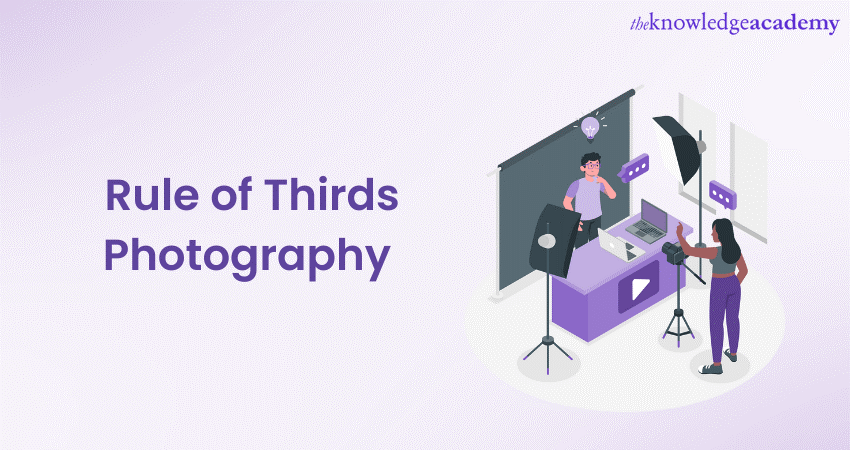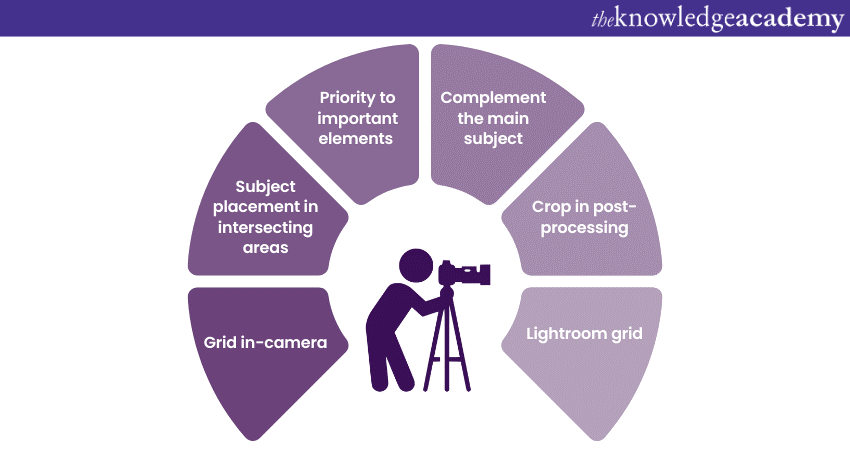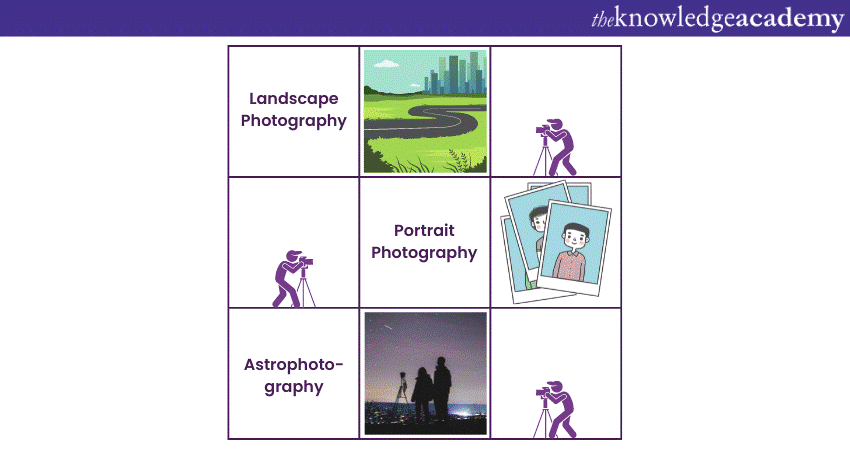We may not have the course you’re looking for. If you enquire or give us a call on 01344203999 and speak to our training experts, we may still be able to help with your training requirements.
Training Outcomes Within Your Budget!
We ensure quality, budget-alignment, and timely delivery by our expert instructors.

Rule of Thirds Photography is a key to unlocking captivating compositions. Rooted in dividing an image into nine equal parts, this principle strategically places subjects at intersecting points or along gridlines. By doing so, it injects dynamism, balance, and harmony into visuals.
According to a Marketsplash report, the value of the Photography industry market is projected to reach over 36 billion GBP by 2025. The same report reveals that the density of professional Photographers globally has crossed 70 million individuals. These statistics indicate the exponential increase in the demand for Photographers and their diverse range of skills.
Explore visual art with Rule of Thirds Photography by enhancing your skills, learning techniques, and creating captivating images using this fundamental principle.
Table of Contents
1) Understanding what is the Rule of Thirds
2) How do you apply the Rule of Thirds?
3) Examples of Rule of Thirds Photography
4) Exceptions to the Rule of Thirds
5) Conclusion
Understanding what is the Rule of Thirds
The Rule of Thirds is an elementary compositional principle in visual arts and Photography, designed to enhance the balance, harmony, and visual appeal of an image. The concept involves dividing the frame into nine equal segments using two horizontal and two vertical lines, resulting in a grid of intersecting points.
By strategically placing key elements along these lines or at their intersections, the Rule of Thirds in Photography guides the viewer's gaze, creating a dynamic and engaging composition. This technique not only avoids the monotony of centred subjects but also encourages the exploration of negative space, enriching the overall visual experience.
Whether in portrait, landscape or still-life Photography, adhering to the Rule of Thirds brings a sense of equilibrium and depth to the image, capturing attention while maintaining an aesthetically pleasing balance.
While mastering this principle can greatly enhance the quality of one's photographs, it's important to recognise that creative interpretation and deviation from the rule can also lead to unique and compelling compositions.
How do you apply the Rule of Thirds?
The Rule of Thirds, a key principle in Photography composition, finds application across genres. In portraits, it intensifies gazes; in landscapes, it balances sky and land. Still life gains structure, and architecture gains dynamism. While a foundation for harmonious visuals, skilled deviation allows for engaging, innovative compositions.
Here are the many ways by which you can apply the Rule of Thirds:

Grid in-camera
The Grid in-camera technique in Photography is a valuable tool that modern cameras and smartphones offer to Photographers. It involves overlaying a grid of lines onto the camera's viewfinder or screen, dividing the frame into thirds both horizontally and vertically.
Additionally, this grid acts as a visual guide, helping Photographers compose their shots according to the Rule of Thirds principle. By aligning key elements along these gridlines or at their intersections, Photographers achieve balanced and dynamic compositions.
Furthermore, the grid in-camera technique enhances the Photographer's ability to capture visually pleasing images directly through the camera's viewfinder, reducing the need for extensive post-processing adjustments.
This feature empowers Photographers to make real-time compositional decisions, resulting in compelling and well-composed photographs that effectively engage viewers' eyes and emotions.
Subject placement in intersecting areas
Strategically placing the subject at the intersecting areas of the Rule of Thirds grid is a powerful composition technique in Photography. These points, where the horizontal and vertical lines intersect, draw the viewer's attention and create a focal point with significant visual impact.
Placing the subject at these intersections can add depth, balance, and dynamic energy to the composition. For portraits, the subject's eyes might align with an intersection, intensifying the connection with the viewer. In landscapes, a key element like a tree or mountain peak can find its place at an intersection, enhancing the overall visual appeal.
Moreover, this technique encourages the viewer's eye to explore the image, following a more engaging visual path. By thoughtfully positioning the subject within these intersecting areas, Photographers can create captivating and well-balanced compositions that resonate with the audience.
Priority to important elements
Prioritising important elements within a photograph is a fundamental aspect of composition, closely tied to the Rule of Thirds principle. By placing key subjects or focal points along the gridlines or at their intersections, Photographers guide the viewer's attention directly to these crucial elements.
Additionally, this strategic placement in Photography ensures that the main subject takes precedence, commanding the viewer's focus in a visually compelling manner. The Rule of Thirds aids in achieving this priority by avoiding centering the subject, which can result in a static composition. Instead, the technique instils a sense of dynamism, enabling the viewer's eye to journey through the image while maintaining harmony and balance.
Whether in portrait, landscape, or architectural Photography, giving priority to important elements through Rule of Thirds-inspired composition elevates the overall impact of the photograph, conveying the intended message and emotions with precision.
Complement the main subject
Complementing the main subject is an artful application of the Rule of Thirds in Photography. By placing secondary elements or points of interest along the gridlines, Photographers create a harmonious interplay that enhances the main subject's narrative.
Additionally, these complementary elements add context, depth, and visual interest, allowing the viewer to engage with the image on multiple levels. For instance, a portrait subject might be positioned on one intersection while a relevant object, like a musical instrument, aligns with another intersection, offering insights into the subject's personality.
Moreover, in landscapes, the main subject, such as a solitary tree, could be accompanied by a river or a distant mountain placed on the gridlines, offering context and scale. This technique enriches the photograph, transforming it into a storytelling medium that captivates the viewer's imagination and invites them to explore the visual narrative with curiosity.
Crop in post-processing
Post-processing crops based on the Rule of Thirds is a transformative technique in Photography. It allows Photographers to refine and enhance compositions by adjusting the placement of key elements during the editing phase.
Additionally, cropping enables a second chance to align subjects with gridlines or intersections, optimising visual balance and impact. This process can eliminate distracting elements, focus on the core subject, and fine-tune the overall composition.
More importantly, it's an opportunity to explore different interpretations of the same image, experimenting with various placements and achieving a stronger emotional connection with the viewer.
Moreover, by using Cropping in post-processing to align with the Rule of Thirds, Photographers harness the power of composition even after capturing the shot, ensuring that their creative vision is faithfully translated into a captivating and compelling visual story.
Lightroom grid
The Lightroom grid is a versatile and indispensable tool within Adobe Lightroom, a popular photo editing software. It aids Photographers in implementing compositional principles such as the Rule of Thirds.
Now, the grid overlay consists of horizontal and vertical lines that dissect the image into thirds, providing a visual guide for precise placement of key elements. This tool enhances post-processing efficiency, allowing Photographers to align subjects with the gridlines and intersections, even after the shot is taken.
Furthermore, the Lightroom grid not only facilitates adherence to composition rules but also empowers creative experimentation. By adjusting crops and placements, Photographers can optimise the visual impact of their images.
Moreover, this dynamic feature underscores the significance of composition in visual storytelling, enabling Photographers to transform their raw captures into engaging, balanced, and harmonious visual narratives.
Examples of Rule of Thirds Photography
Here are three key examples of the Rule of Thirds, explained in detail as follows:

Landscape Photography
Landscape Photography beautifully exemplifies the Rule of Thirds' impact on composition. When applied to landscapes, this principle guides Photographers to position the horizon along the upper or lower horizontal line, depending on whether the sky or foreground demands emphasis.
Additionally, the placement prominent features like mountains, trees, or bodies of water at the intersections or along the gridlines inject dynamism and balance. For instance, a stunning sunset could have the sun aligned with an intersection, drawing attention to the vibrant sky, while the foreground occupies the lower portion.
Furthermore, by adhering to the Rule of Thirds, Landscape Photographers infuse their images with depth, guiding viewers' eyes across the scene and evoking an emotional response. This technique elevates landscape Photography from mere documentation to powerful visual storytelling, capturing the grandeur of nature while adhering to timeless compositional principles.
Improve the quality and appeal of your visual content, by signing up for the Photo Retouching Training now!
Portrait Photography
In Portrait Photography, the Rule of Thirds transforms Portraits into compelling character studies. Placing the subject's eyes near the upper intersections creates an engaging connection, drawing the viewer into the subject's gaze. The grid ensures that the subject isn't centred, infusing the composition with a sense of energy and avoiding the state of being static. Furthermore, aligning facial features with the gridlines ensures a balanced and harmonious result.
For example, a Portrait subject could have their eyes on the upper horizontal line, while their mouth aligns with a vertical line, creating a balanced yet dynamic composition. The Rule of Thirds doesn't just guide positioning, but also enhances the narrative by allowing the subject to interact with their surroundings.
As a result, Portrait Photographers use this technique to craft visually arresting images that resonate emotionally and narrate stories through the subjects' expressions and interactions.
Astrophotography
Astrophotography and the Rule of Thirds unite to compose mesmerising celestial vistas. By placing the Milky Way, stars, or planets along the gridlines or at intersections, Astro-Photographers add structure to the seemingly boundless night sky.
Moreover, aligning the horizon with the lower third can accentuate foreground elements, like silhouetted landscapes or trees, providing context and scale. Placing celestial wonders near intersections not only draws the viewer's eye but also generates a sense of awe and wonder.
More importantly, the Rule of Thirds aids in preventing overemphasis on a singular element, creating a balanced cosmic symphony. This technique showcases the marriage of art and science, where the celestial realm adheres to earthly composition principles, resulting in breathtaking and harmonious Astro-photographs that resonate with both experienced stargazers and those new to the cosmos.
Exceptions to the Rule of Thirds
Here is a list containing the various exceptions to the Rule of Thirds:
Finding a balance
While the Rule of Thirds is a powerful guideline, occasionally finding balance through centred composition can create impactful visuals. This exception draws attention to the subject's symmetry or significance, fostering a unique sense of focus.
Additionally, centering can evoke calmness or emphasise a subject's strength. However, it's essential to do so intentionally, ensuring the subject truly warrants this central spotlight. Balancing the dynamic Rule of Thirds with centred compositions adds variety to your photographic arsenal, underscoring the importance of purposeful deviation from the norm for heightened artistic expression.
Make use of leading lines
While the Rule of Thirds is a cornerstone, embracing leading lines offers a compelling exception. These lines, naturally occurring or man-made, guide the viewer's eye through the frame, often leading to a centred subject.
Moreover, this technique injects depth and motion, creating a captivating narrative. Leading lines can emanate from various points, converging on the subject, intensifying its impact. When skillfully employed, this exception transforms compositions into engaging visual journeys, demonstrating that breaking the rule can yield powerful storytelling.
Fill the frame
Contrary to the Rule of Thirds, "Filling the frame" exception involves placing the subject at the centre, intensifying intimacy and impact. This technique eliminates distractions and immerses viewers in the subject's details.
By breaking the rule, you emphasise texture, emotion, or intricate elements that might have been lost with traditional composition. This approach works wonders for portraying close-ups or highlighting intricate patterns.
However, precision is key, as the subject's significance must warrant this direct focus. Filling the frame showcases the potency of centred composition, adding a versatile tool to your visual storytelling toolkit.
Utilise a different composition technique
Diverging from the Rule of Thirds occasionally involves embracing alternative composition techniques. One such exception is the ‘Golden Ratio’ which emphasises a spiral-like placement of subjects for a more harmonious arrangement.
Now, this approach creates a captivating flow, drawing the viewer's eye through the frame in a dynamic manner. While different, the Golden Ratio maintains a balance and engagement that align with the Rule of Thirds.
By integrating various composition techniques, you enrich your creative palette, proving that breaking the rule can yield imagery that's both visually appealing and thought-provoking.
Conclusion
The Rule of Thirds in Photography remains a steadfast guide, but its mastery lies in knowing when to deviate. From Portraits, Landscapes, and Astrophotography to leading lines, embracing exceptions adds depth to your storytelling. Rule of Thirds Photography becomes a launchpad for creativity, forging captivating visual narratives.
Increase your brand value with improved tonality and lens qualities, by signing up for the Photography Masterclass now!
Frequently Asked Questions
Upcoming Business Skills Resources Batches & Dates
Date
 Photography Course
Photography Course
Fri 14th Jun 2024
Fri 13th Sep 2024
Fri 13th Dec 2024







 Top Rated Course
Top Rated Course



 If you wish to make any changes to your course, please
If you wish to make any changes to your course, please


